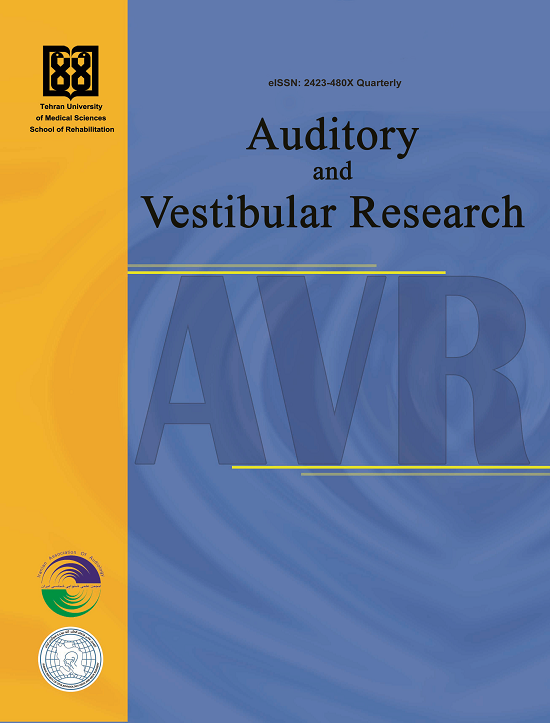Comparison of intonation production in cochlear-implanted children and normal hearing children
Abstract
Background and Aim: Due to defects of auditory feedback, children with hearing loss have inappropriate speech intonation. Consistently, results of previous studies have shown that cochlearimplanted children have some difficulties in their intonation. Intonation shows the type of the sentence which can be statement or question sentences. The purpose of this study was comparison of speech intonation in cochlear-implanted children and normal hearing children.
Methods: The present study was performed on 25 cochlear-implanted children and 50 normal hearing children. Different pictures were shown to the subjects and they said statement and question sentences. All sentences were heard by eight speech therapists and perceptually judged. Using praat software mean base frequency and pitch alterations were measured.
Results: In cochlear-implanted group, mean speech base frequency was higher and mean pitch alteration was lower than the control group. Mean experts’ scores in cochlear-implanted group were lower than the control group. Differences in all three variables were statistically significant (p<0.05). There was a significant direct correlation between duration of time that the children had cochlear implant and perceptual judgment scores (p<0.05).
Conclusion: According to the results, cochlear implant prosthesis has limited efficacy in improving speech intonation; although their ability to produce speech intonation improves by increasing duration of the time that children have cochlear implant. Thus speech therapists should consider intervening on speech intonation in treatment program of cochlear-implanted children.
2. Snow D. Intonation in the monosyllabic utterances of 1-year-olds. Infant Behavior & Development. 2002;24(4):393-407.
3. Allen GD, Arndorfer PM. Production of sentence-final intonation contours by hearing-impaired children. J Speech, Lang Hear Res. 2000;43(2):441-55.
4. Peng SC, Tomblin JB, Spencer LJ, Hurting RR. Acquisition of rising intonation in pediatric cochlear implant recipients-a longitudinal study. International Congress Series. 2004;12(2):336-9.
5. Han D, Zhou N, Li Y, Chen X, Zhao X, Xu L. Tone production of mandarin Chinese speaking children with cochlear implants. Int J Pediatr Otorhinolaryngol. 2007;71(6):875-80.
6. Peng SC, Tomblin JB, Spencer LJ, Hurting RR. Imitative production of rising speech intonation in pediatric cochlear implant recipients. J Speech, Lang Hear Res. 2007;50(2):1210-27.
7. Peng SC, Tomblin JB, Turner CW. Production and perception of speech intonation in pediatric cochlear implant recipients and individuals with normal hearing. Ear Hear. 2008;29(3):336-51.
8. Lenden JM, Flipsen P Jr. Prosody and voice characteristics of children with cochlear implants. J Commun Disord. 2007;40(1):66-81.
9. Brown C, McDowall DW. Speech production results in children implanted with the CLARION implant. Ann Otol Rhinol Laryngol Suppl. 1999;177:110-2.
10. Snow D, Ertmer D. The development of intonation in young children with cochlear implants: A preliminary study of the influence of age at implantation and length of implant experience. Clin Linguist Phon. 2009;23(9):665-679.
11. Geers AE, Nicholas JG, Sedey AL. Language skills of children with early cochlear implantation. Ear Hear. 2003;24(1 Suppl):46S-58S.
12. Tait ME, Nikolopoulos TP, Lutman ME. Age at implantation and development of vocal and auditory preverbal skills in implanted deaf children. Int J Pediatr Otorhinolaryngol. 2007;71(4):603-10.
| Issue | Vol 21 No 2 (2012) | |
| Section | Research Article(s) | |
| Keywords | ||
| Cochlear implant speech expression intonation primary-school children | ||
| Rights and permissions | |

|
This work is licensed under a Creative Commons Attribution-NonCommercial 4.0 International License. |






